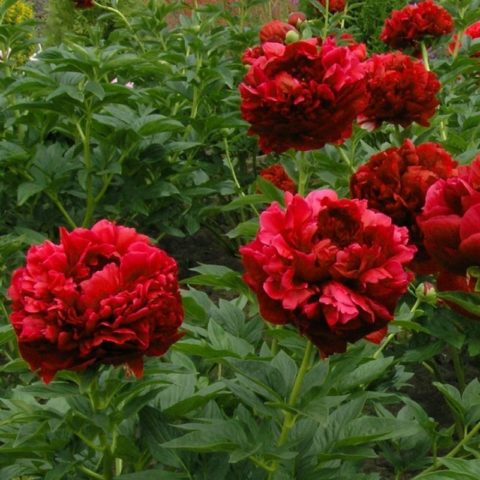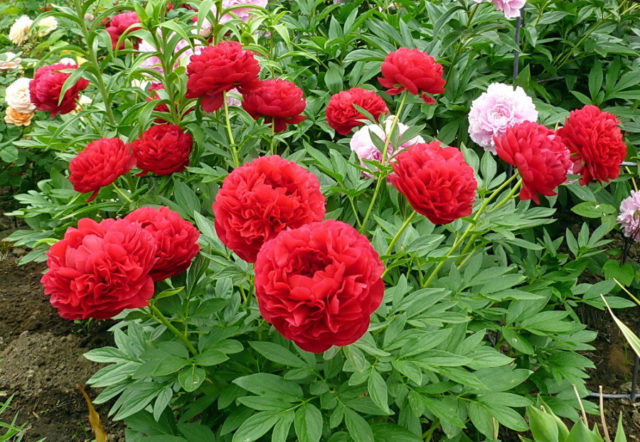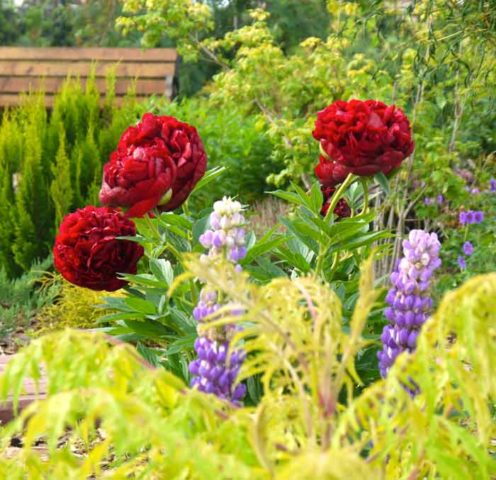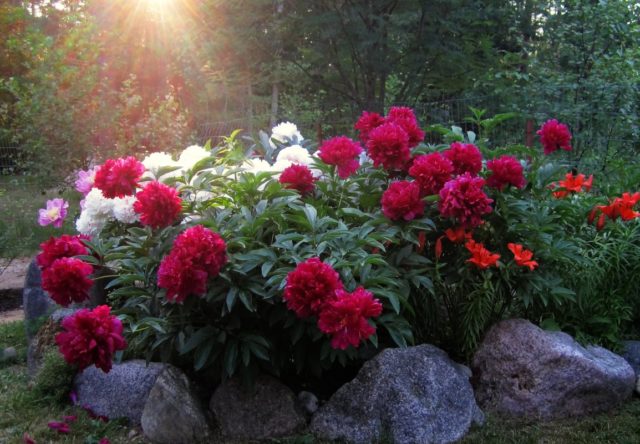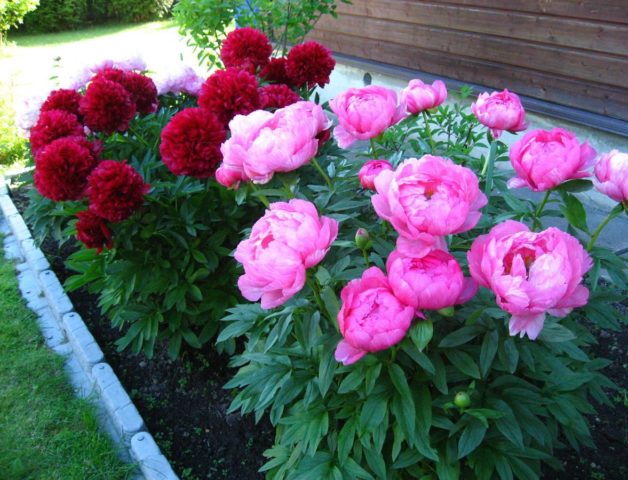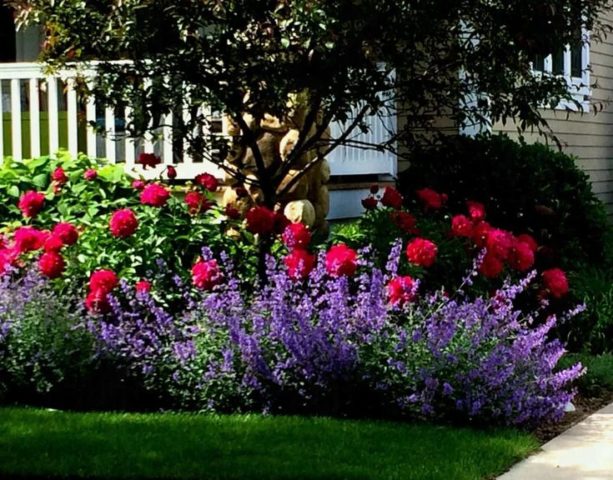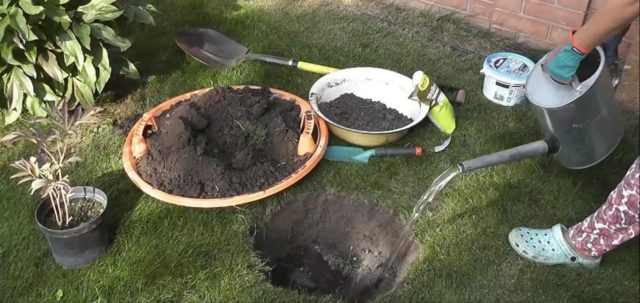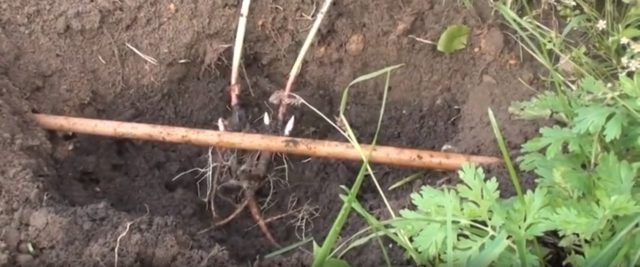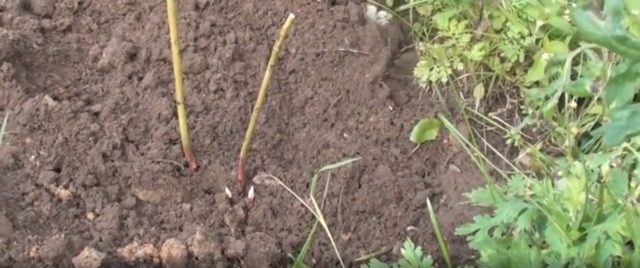Content
Carol's peony is an interspecific cultivar with bright double flowers. The herbaceous shrub is characterized by a high degree of frost resistance and is popular with gardeners throughout Russia. They grow a culture for cutting and decorating the territory.
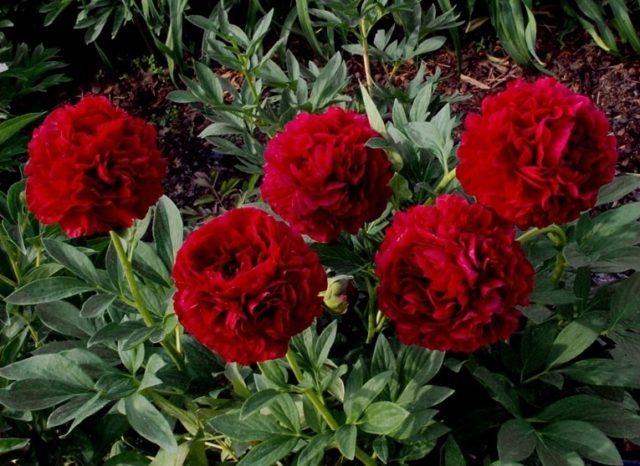
The stems of the Carol variety are straight, without bends, suitable for cutting
Description of Peony Carol
Peony Carol is a perennial herbaceous shrub with a dense spreading crown. Forms many shoots, reaching a length of 80 cm. Stems are erect, tough, dark green in color. Under the weight of the flowers, the shoots droop, the bush disintegrates and loses its decorative effect.
The leaf plates are dark green, lanceolate, hard, glossy, with smooth edges. The arrangement of leaves is alternate, petioles are long, slightly pubescent.
Peony Carol is a sun-loving plant, therefore it does not tolerate shading well. Only with full-fledged photosynthesis will the culture bloom profusely, quickly build up the root system and green mass. The variety is frost-resistant, withstands temperature drops to -35 0C, and also has good drought resistance.
These qualities make it possible to grow the Carol variety throughout the temperate climate. The variety is especially popular with gardeners in the European and Central part of Russia.
Flowering features
Carol peony of medium early flowering period. The buds are formed at the end of May, bloom in the first decade of June. The life cycle of the inflorescence is 7 days, the duration of the flowering period is 15 days. Each stem gives up to three lateral shoots, buds are formed on them.
Abundant flowering, splendor depends on timely feeding and sufficient lighting. If the crop is grown for cutting, the side buds are removed, then the center flower will be larger.
How the Carol variety blooms:
- flowers are large, double, 20 cm in diameter;
- petals of a bright red saturated color with a purple tint, the arrangement is folded, uneven;
- the central part is closed.
Application in design
An ornamental herbaceous shrub with sufficient lighting can be grown in flowerpots on a balcony or loggia. It must be borne in mind that under the weight of the inflorescences, the peony disintegrates and looks untidy, therefore, you must first take care of the support. The plant is grown outdoors for garden design, combining with many flowering crops that have the same biological requirements:
- daylilies;
- veronica;
- bells;
- cornflowers;
- with flowering and ornamental shrubs;
- hydrangea.
Carol does not combine with roses or other flowers of a red hue, since they will lose their attractiveness against the background of a peony. Peony does not get along well with juniper due to different requirements for the composition of the soil, but with thuja and dwarf forms of spruce it looks perfect.
A few examples of the use of the Carol variety in garden design:
- registration of the central part of the lawn;
- planted in combination with different varieties of peonies to frame flower beds;
- create a color accent in the central part of the flower bed;
- for the decor of rockeries;
A mix of different varieties of peony with daylily looks good
- planted on a bed near the building;
- include in a composition with decorative and flowering plants;
Reproduction methods
The interspecific variety of peony Carol is sterile, so the plant can be propagated vegetatively.
When grafting, the material is cut from strong shoots until the budding period. They are placed in water, and when root threads appear, they are transferred to the ground. It will take 3 years from the moment of harvesting the material to flowering. The method is possible, but lengthy.
The most optimal breeding option for an elite Carol variety is by dividing an adult plant. Work is carried out in the fall, and in the spring buds will appear on the young shrub.
Landing rules
Ito hybrid Carol can be placed on the site at the beginning of the growing season, when the soil has warmed up to +10 0C. Spring work is relevant if the material purchased in the nursery is planted. The peony will bloom only after three years of growth, before winter it will have time to take root well. For plots, the optimal period is at the end of summer or at the beginning of autumn. The plant will bloom next season. If you divide the mother bush in the spring, the peony will not bud, the summer time will be spent on adaptation.
Plot requirement:
- it should be a well-lit place, periodic shading is allowed;
- the soils are neutral, the peony will not grow on an acidic composition, on an alkaline composition it will not give lush flowering and rich color of petals;
- the land is chosen light, fertile, if necessary, the soil is corrected by adding sand during planting and regular dressing;
- Do not place Carol's peony in swampy lowlands.
Delenki are used for planting. A well-grown plant is chosen that is at least three years old.
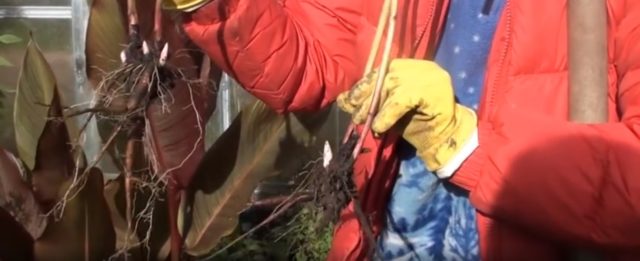
The bush is dug up, divided in such a way that on each instance there are at least three vegetative buds
The soil is completely shaken off or washed off with water.
If a seedling is purchased with a closed root, it is placed in a pit along with an earthen lump.
The seedling is poured with water and carefully removed from the transport container so as not to damage the root.
Planting Peony Carol:
- the pit is prepared 2 weeks before the planned work, they are dug with a depth and width of 50 cm;
- the bottom is closed with drainage and a soil mixture of peat and compost, left to the edge 20 cm;
- after preparation, the pit is filled with water, the procedure is repeated the day before planting;
- for a peony, it is important to correctly position the buds, they are deepened no lower and no higher than 5 cm;
- for this, a rail is placed on the edge of the recess, soil is poured;
Regulate the deepening of the kidneys and tie the root to the bar
- fall asleep with sod soil mixed in equal parts with compost;
- if the buds have started to grow, their tops are left above the ground level;
If the buds are deepened, the peony will not bloom this season.
Follow-up care
Carol's hybrid is one of those peony varieties for which feeding is necessary throughout the growing season, except for the flowering time.
Carol's peony feeding schedule:
- at the beginning of spring, when the first shoots appear, potassium is added under the bush;
- at the time of tying the buds, they give nitrogen and superphosphate;
- after flowering, fertilize with organic matter and ammonium nitrate, the measure is necessary to lay vegetative buds for the next season;
- at the end of August, fertilized with complex mineral products;
- during preparation for winter, the Carol variety is fed organic.
Watering the peony is necessary during the entire warm period. An adult bush needs 20 liters of water for 10 days. A young peony is watered to prevent compaction and waterlogging of the soil.
A prerequisite is mulching the root circle, in the fall the layer of material is increased, in the spring it is completely renewed. Mulch will retain moisture and prevent the soil from drying out, eliminating the need for constant loosening of the soil.
Preparing for winter
The Carol variety belongs to frost-resistant crops, therefore, for an adult plant, a thorough shelter for the winter is not required. The bush is cut off completely after the first frost, water charging is carried out, fed with organic matter and covered with mulch.
For seedlings of the Carol variety, the layer of mulch is increased, insulated with straw, and protected from above with any covering material.
Pests and diseases
Carol's interspecific hybrid is characterized by high resistance to infections, the culture is very rare. The peony calmly tolerates a period of prolonged rains, the only problem may be poorly drained soil. In conditions of excessive humidity, the shrub is affected by a fungal infection (gray rot), which can only be eliminated by transferring the bush to a dry, well-lit place.
Of the pests, the appearance of a gall nematode on the peony is possible, which affects the root only in constantly waterlogged soil. With the massive distribution of the bronze beetle on the site, the pest can also parasitize on the Carol variety.

At the first signs of the appearance of insects, the shrub is treated with insecticides (for example, Kinmix)
Conclusion
Peony Carol is a herbaceous shrub with a long life cycle that can bloom in one place for more than 10 years. It quickly builds up the root system and green mass, the variety has intensive shoot formation, and stable flowering. The flowers are large, double, maroon color. The variety is suitable for decorative gardening and flower arrangement.
Reviews about peony Carol
